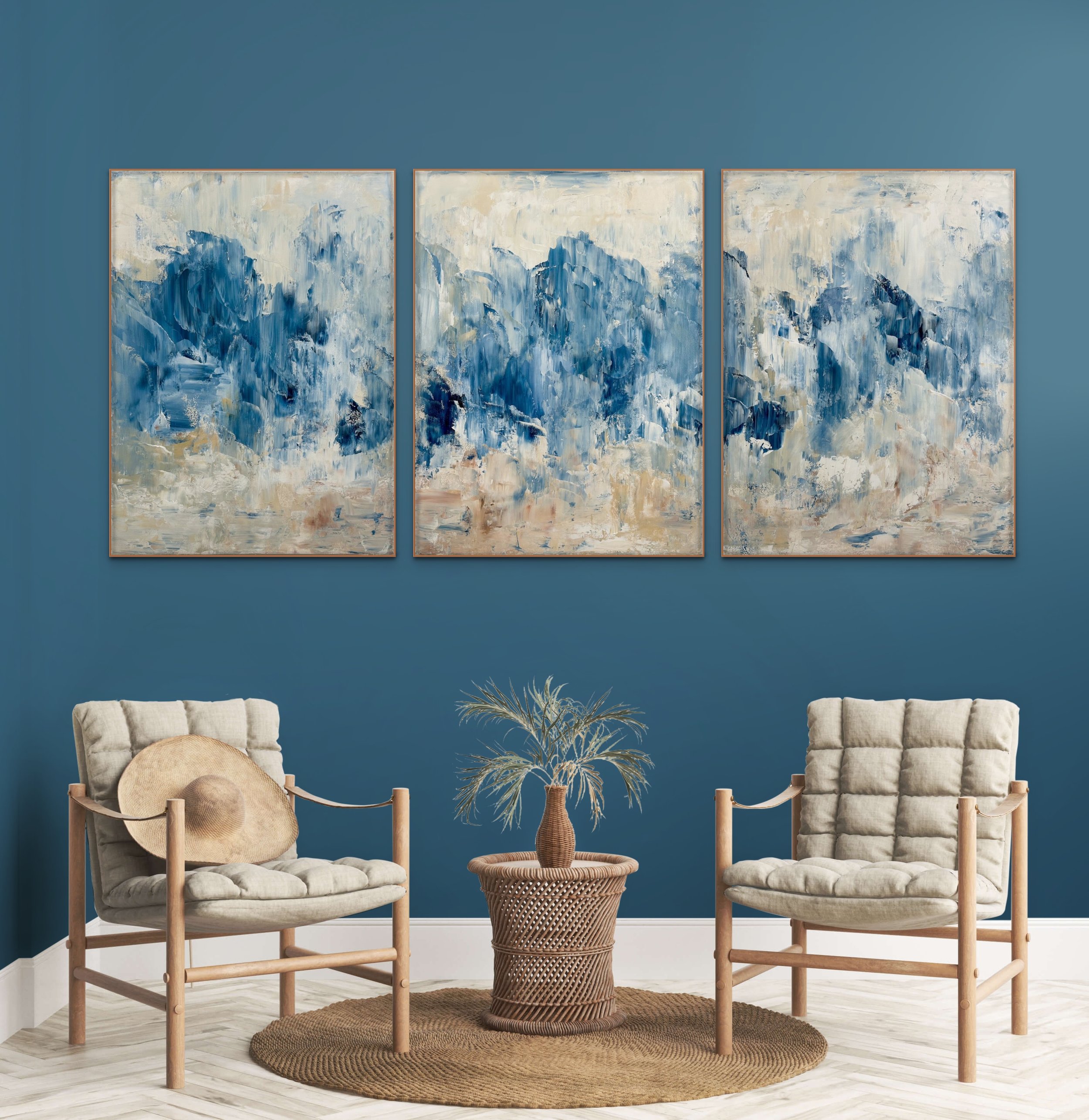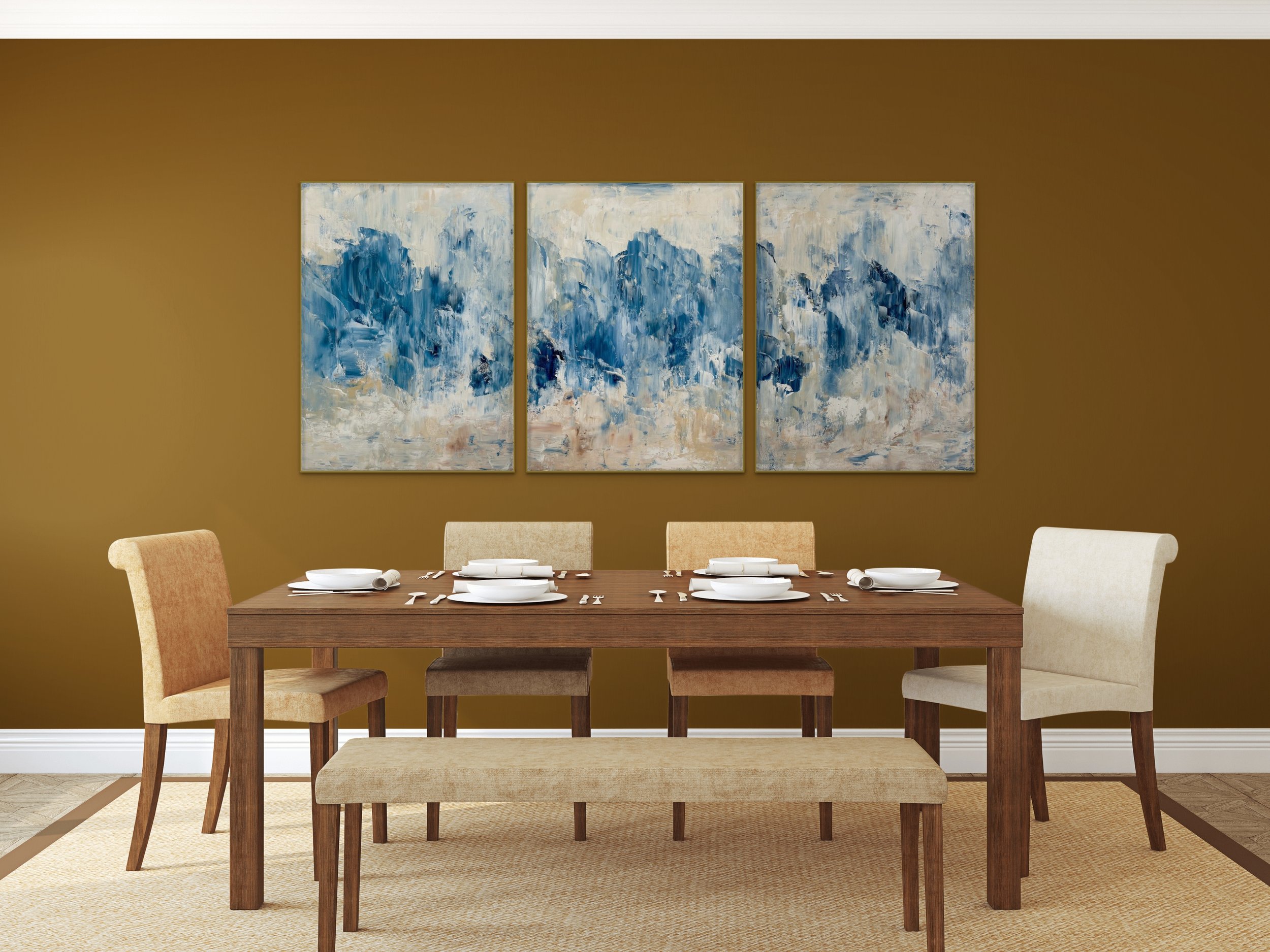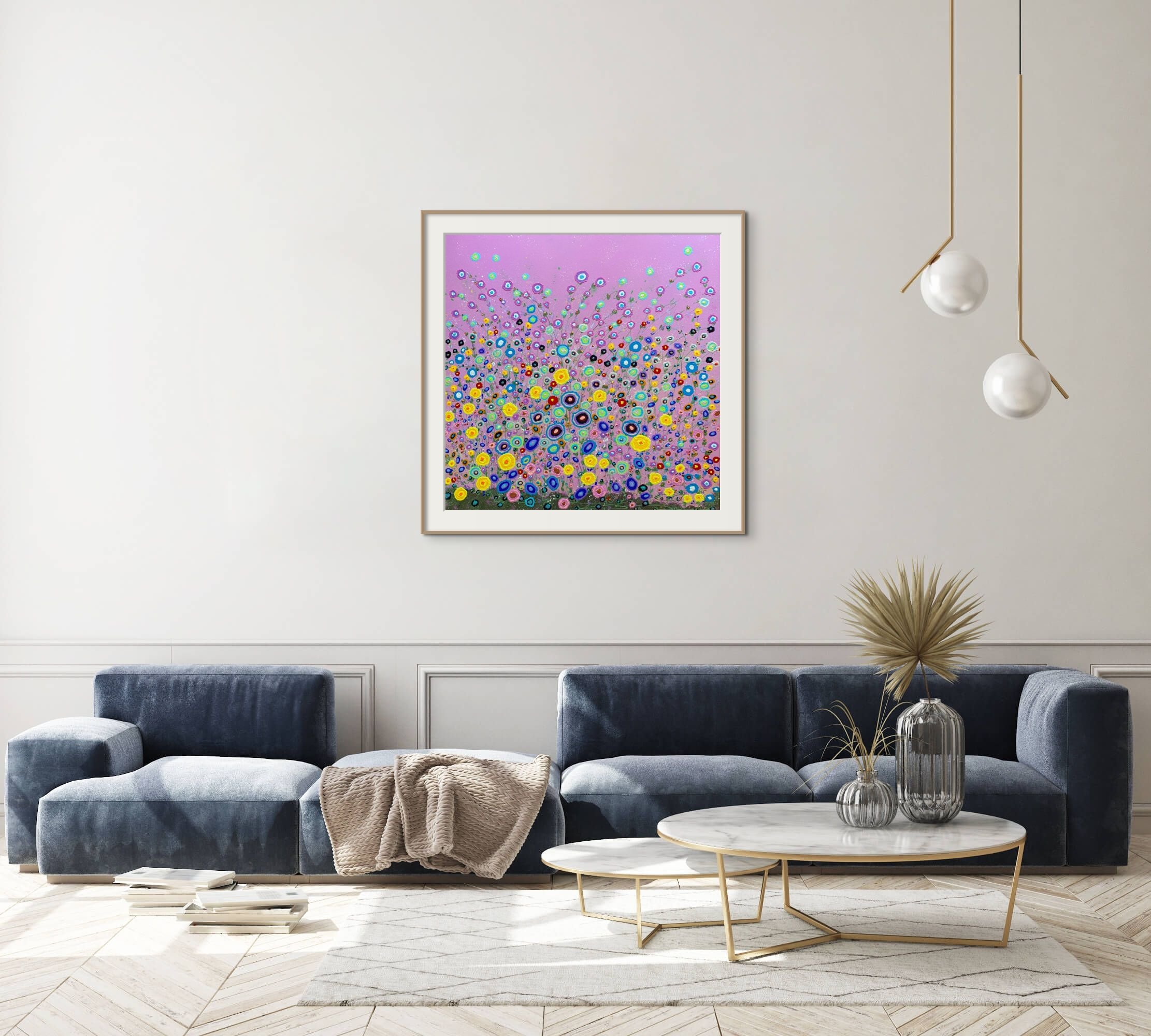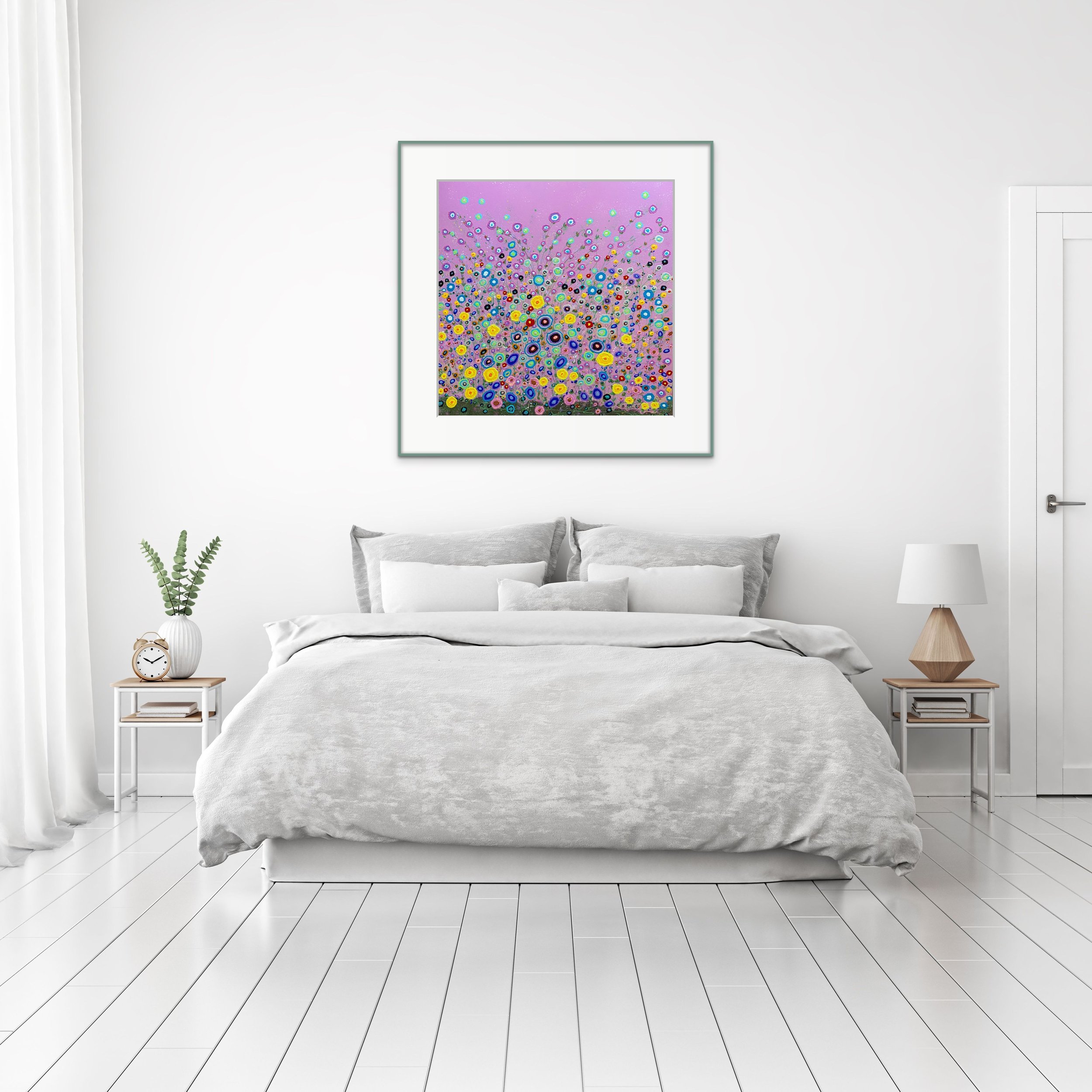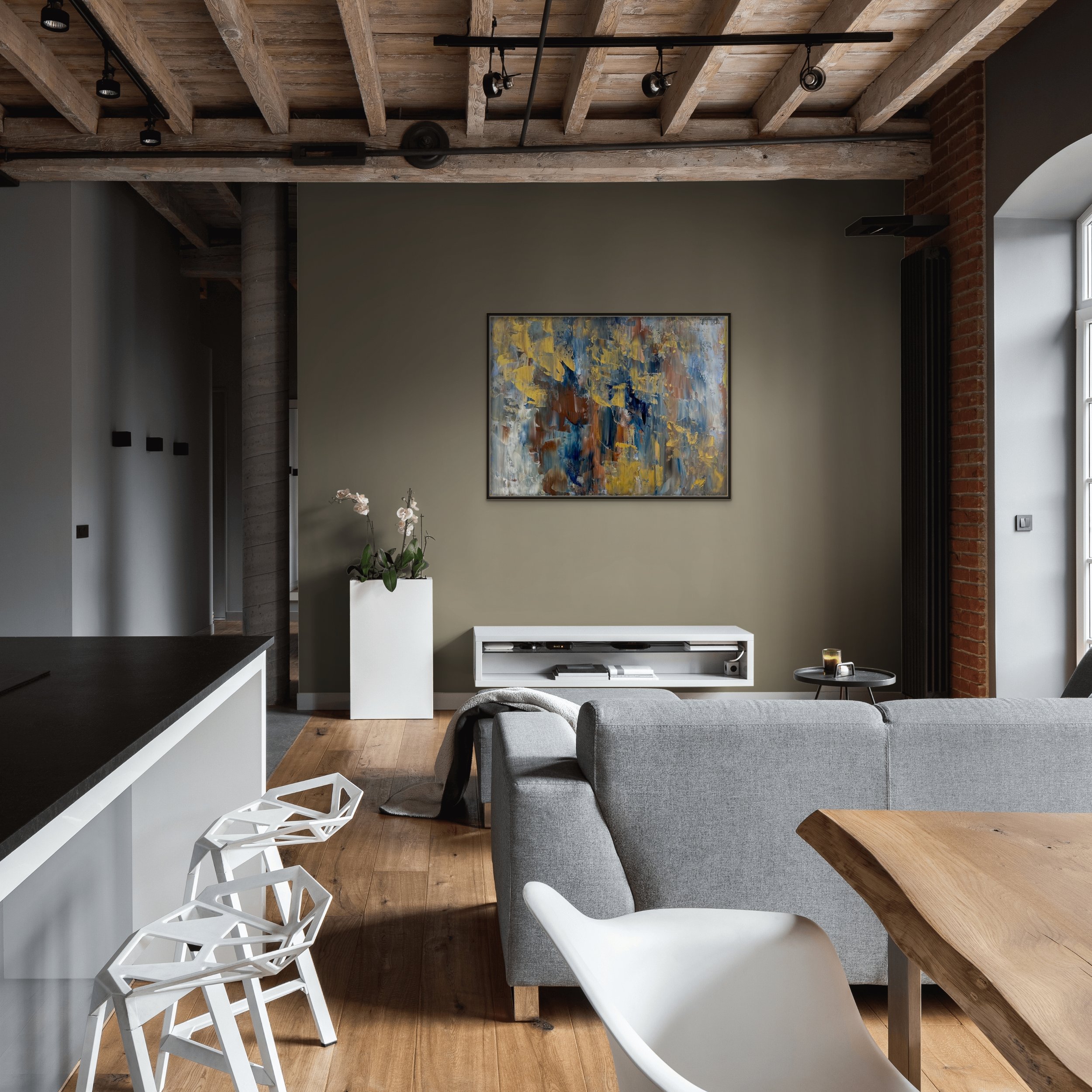Anatomy Of An Art Sale
One thing I do as an online art business owner is take responsibility for giving clients a super easy, stress-free buying experience.
My evidence-based design art business is not without its challenges. I live in a clean, safe, nature-filled part of Northern Michigan. It’s a fabulous place to create evidence-based design art, but it’s SUPER REMOTE.
I sell online at https://dorotheasandraart.com and https://singulart.com/en/artist/dorothea-sandra-36937 and I’m galleries in the U.S., but I also like to sell locally. I’m fortunate that about 40 miles away there’s a town called Alpena, Michigan. I really enjoy Alpena and call it my “authentic” arts town because it has not yet become too commercialized. It’s busy with so many downtown festivals and so many summertime visitors from all over the world. In 2024, Viking Cruise Ships on their Great Lakes Tours will stop 26 times in Alpena’s harbor.
Recently, at the Art In The Loft gallery in downtown Alpena, I sold a 6’x9’ painting called Wildflower Wonderland.
A cruise ship visitor from Kansas City, Missouri fell in love with this evidence-based design work of art. She really wanted to buy it but had no idea how to purchase it (while on a cruise) and then get it up on the wall in her home. The staff at Art In The Loft told her I shipped internationally and nationally and gave her my art studio number. When she called, I assured her I would take her through the sale step-by-step.
(Image source: Alpena News)
After she made the purchase, the first thing I did was have the painting taken off the gallery wall, wrapped back up, and transported back to my studio. In the studio, I then examined the painting and rewrapped it in acid-free glassine paper (which protects against moisture, air, and grease).
I gave the painting additional protection by wrapping it in bubble wrap and had a shipping crate prepared.
Another Dorothea Sandra work of art ready for UPS shipping pick up.
While this was going on, I got on the phone and called framing shops in Kansas City, Missouri to arrange for the painting to be stretched and attached to a wooden frame.
Why didn’t I stretch and frame the painting here in Michigan and then ship it to Missouri? If I had tried to ship a 6’x9’ framed painting, the cost would have been too expensive.
Finding the right stretching/frame shop for a client is one of the trickiest parts of the sale.
The first place I called—a well-known art chain store in Kansas City—wouldn’t stretch such a large painting. The second place I called—a framing store with corporate clients—at first said stretching a 6’x9’ wouldn’t be a problem and would only costs a couple hundred dollars, which is a good price for a stretch. The second time I called to confirm the sale, the manager told me he’d get back to me in 10 minutes. After waiting, I called him back an hour later and an employee told me he was busy talking to customers. He never did call me back. The third place I called—the Brookside Gallery on 114 W. 63rd Street in Kansas City—was fabulous. They were a tiny bit more expensive, but they could easily trim and stretch a 6’x9’. We decided to ship the painting directly to them, which would save the buyer any to-and-from transport headaches.
When I make arrangements like this for my buyers, I always look for extreme business competence and excellent customer care. The Brookside Gallery also agreed to connect my buyer with their local art transport company/wall installer.
One thing I do as an art business owner is take responsibility for giving clients an easy, stress-free buying experience.
I figure if I am taking the extra time to create evidence-based design art that triggers the brain to produce happiness chemicals, then I should also take the time to create buying experiences that also produce happiness chemicals in the brain.
In the end, my client who bought an evidence-based work of art while on a cruise, will have been taken care of every step of the way.
I told her, until the painting is installed exactly the way she wants it on her wall, we are in this together.
Creating Joy In Abstract Art
Is it possible to create a modern work of abstract art that triggers the brain to create feelings of joy?
Is it possible to create a modern work of abstract art that triggers the brain to create feelings of joy?
Personally, I’m convinced of it. What is my reasoning? Buyers tell me all the time how happy my art actually makes them feel.
What’s the secret? Is it super talent or artistic genius or is it training and certification in Evidence-Based Design? I believe it’s a combination of talent and training. Based on established medical and scientific research, I know there are relationships between design factors and healthcare outcomes, especially when people view nature. I create and sell an abundance of nature scenes (see my websites dorotheasandra.com and the landscape category of thewonderfulworldofdorotheasandraart.com) but I also love to create and believe in abstract art as health and happiness sources.
I’m a member of The Society of Experimental Artists and also hold the EDAC (Evidence-Based Design Accreditation and Certification) designation, so I have a keen interest in trying new and different ways to create art.
Joyful Movements by Dorothea Sandra
In this triptych titled Joyful Movements, I experimented with using acceptable “evidence-based design” colors (soft and gentle) and combining them with “the abstract essences” of nature’s wind, rocks, sand, and water. Solely as an abstract work of art, Joyful Movements holds it own. The colors are amazingly beautiful and the palette knife movements create deep interest and intrigue.
My goal when designing this was to see if I could connect “evidence-based design” guidelines with “abstract art” techniques, so I stuck with “the essences” of nature—rather than identifiable shapes—for the purpose of keeping the composition free of too much impact and stress. I wanted this piece to be beautiful, but I also wanted it to do more for us. I wanted it to be gentle and soothing and to remind of us of nature’s amazing healing powers.
I wanted the brains of viewers to be reminded of nature’s water and sand and wind and rocks rather than to be touched (impacted) by them. Many of today’s neuroscientists have conducted studies on our brains and art. Professor Semir Zeki, a neurobiologist from the University of London, discovered in his studies: “When a person views art they find beautiful, it triggers an immediate release of dopamine into the brain—a chemical related to feelings of love, pleasure, and desire.”
Pierre Lemarquis, a French neuroscientist, concluded: “Art of all kinds acts on our brains in a multi-faceted dynamic way. Neural networks are formed to achieve heightened complex states of connectivity. Art can sculpt and even caress our brains.”
My overall desire for Joyful Movements was to achieve a work of art with moving nature essences that evoked in us feelings of happiness and healing.
Although this painting was created after 100 Days Of Happy Happy Art, Evidence-Based Design was published, here is an excerpt about designing with water from my book. There’s more to just painting water and nature elements when it comes to meeting all the evidence-based design standards.
For me to create “happy” art, I remember that the medical/scientific “evidence” matters.
“In evidence-based art, compositions with water should provide healing. Calm water scenes are preferred, while gushing rapids or crashing ocean waves should be avoided. Even a trickling water fountain might create negative experiences for people with full or nonfunctioning bladders.” (Distinctive Art Source, “Healthcare Art Bloopers,” 2023)
Creating Joy In Abstract Art
Is it possible to create a modern work of abstract art that triggers the brain to create feelings of joy?
Is it possible to create a modern work of abstract art that triggers the brain to create feelings of joy?
Personally, I’m convinced of it. What is my reasoning? People tell me all the time how happy my art actually makes them feel.
What’s the secret? Is it super talent or artistic genius or is it training and certification in Evidence-Based Design? I believe it’s a combination of talent and training. Based on established medical and scientific research, I know there are relationships between design factors and healthcare outcomes, especially when people view nature. I create and sell an abundance of nature scenes (see my websites dorotheasandra.com and the landscape category of thewonderfulworldofdorotheasandraart.com) but I also love to create and believe in abstract art as health and happiness sources.
I’m a member of The Society of Experimental Artists and also hold the EDAC (Evidence-Based Design Accreditation and Certification) designation, so I have a keen interest in trying new and different ways to create art.
Joyful Movements by Dorothea Sandra
In this triptych titled Joyful Movements, I experimented with using acceptable “evidence-based design” colors (soft and gentle) and combining them with “the abstract essences” of nature’s wind, rocks, sand, and water. Solely as an abstract work of art, Joyful Movements holds it own. The colors are amazingly beautiful and the palette knife movements create deep interest and intrigue.
My goal when designing this was to see if I could connect “evidence-based design” guidelines with “abstract art” techniques, so I stuck with “the essences” of nature—rather than identifiable shapes—for the purpose of keeping the composition free of too much impact and stress. I wanted this piece to be beautiful, but I also wanted it to do more for us. I wanted it to be gentle and soothing and to remind of us of nature’s amazing healing powers.
I wanted the brains of viewers to be reminded of nature’s water and sand and wind and rocks rather than to be touched (impacted) by them. Many of today’s neuroscientists have conducted studies on our brains and art. Professor Semir Zeki, a neurobiologist from the University of London, discovered in his studies: “When a person views art they find beautiful, it triggers an immediate release of dopamine into the brain—a chemical related to feelings of love, pleasure, and desire.”
Pierre Lemarquis, a French neuroscientist, concluded: “Art of all kinds acts on our brains in a multi-faceted dynamic way. Neural networks are formed to achieve heightened complex states of connectivity. Art can sculpt and even caress our brains.”
My overall desire for Joyful Movements was to achieve a work of art with moving nature essences that evoked in us feelings of happiness and healing.
Although this painting was created after 100 Days Of Happy Happy Art, Evidence-Based Design was published, here is an excerpt about designing with water from my book.
“In evidence-based art, compositions with water should provide healing. Calm water scenes are preferred, while gushing rapids or crashing ocean waves should be avoided. Even a trickling water fountain might create negative experiences for people with full or nonfunctioning bladders.” (Distinctive Art Source, “Healthcare Art Bloopers,” 2023)
Bubbling With Happy Smiles
Today’s art to make us smile.
Creating happiness is a gift, and I love to use my artistic talents to help others smile.
Bubbling With Happy Smiles by Dorothea Sandra
What Happens To Our Brains On Art?
The research results are in: according to The Telegraph in the United Kingdom, “Looking at a gorgeous painting, sculpture, or other artwork, increases blood flow to the brain by as much as 10 percent—the equivalent of looking at someone you love.”
According to professor Pierre Lemarquis, the French neuroscientist who wrote L’art Qui Guérit (Art That Heals) “art of all kinds acts on our brains in a multi-faceted, dynamic way. Neural networks are formed to achieve heightened, complex states of connectivity. Art can sculpt and even caress our brains.”
Isn’t This Exciting?
My goal was to create a work of art that would trigger our brains for fun and laughter and smiles. There’s enough reality in the soil to ground the painting, while the stems take off playfully up and down and around and side to side. The colors are bright and cheerful and full of dynamism and diversity.
So many people have told me this piece instantly busts through bad moods and makes them smile inside. Others have said the flowers communicate that one is perfectly beautiful even when super odd or different or not traditionally formed.
So much of my art is influenced by nature’s water movements and flowers. Here is Bubbling With Happy Smiles, as well as other pieces, on display at the Art In The Loft Gallery in Alpena, Michigan.
People often think of small northern towns as boring. This “authentic arts town” busts with summer activities. Festivals, art, music, water activities, cruise ships docking, amazing natural areas, wildlife, and truly friendly and fun (and open minded) people makes Alpena, Michigan a place I spend lots of time visiting. I’m in two galleries there, and I love it!
Here are some photos of one of the marinas and just one of the many colorful side alleys and back parking lots.





In such a fun and friendly “authentic” place, it’s so easy to get inspired to create happy art. Many of the paintings in my book, 100 Days Of Happy Happy Art, Evidence-Based Design, were influenced by this clean, healthy, and super beautiful area.
This book is not a marketing push. (There are no painting prices published.) It is visually pleasing, as well as an informative journey into a new art field based on science and medical studies called Evidence-based Design.
Creating Power And Beauty In Art
Powerful Beauty is an amazing artwork people love to see.
Powerful Beauty is an amazing piece that people just love to see.
At the opening reception for a summer gallery exhibit, I was standing in front of this painting while talking to a NYC handbag designer for two world-famous fashion brands (who also bought one of my paintings that evening) when a very tall, amazingly elegant woman brushed behind me and whispered, “I l-o-v-e this piece!”
What makes Powerful Beauty such a winner?
To begin with, it was strategically designed to arouse and grab and gently caress. It’s beauty was deliberate and intentional. I am above all else an abstract artist, but I also trained and got certified in evidence-based design. I support the idea of basing designs on actual medical and scientific studies for health and healing and, like the many tools and techniques I use as an artist, I don’t hesitate to use these evidence-based design rules and guidelines while creating even abstract art.
The goal for Powerful Beauty was to create something abstract and full of movement but also balanced, stable, and beautiful to view.
If you would like more information about an artist’s adventures with evidence-based design, check out the book 100 Days Of Happy Happy Art, Evidence-Based Design by Dorothea Sandra.
It’s not just an art book. There’s lots of really cool and thoughtful information in it like, “What Exactly Is The Definition Of Evidence-Based Design?” (Section 1.4) to “What Happens To Our Brains On Art?” (Section 3.1) and “What Is Neuroarts?” (Section 3.2).
So, where did I get the inspiration for this piece? My studio is located in a Great Lakes region surrounded by amazing bodies of water. Almost everywhere I go, I am surrounded by raw, authentic, super clean NATURE. At first sight, this area might look ordinary or just another stretch of beach with rocks and sand, but when you look deeper and capture “the essence” of what is happening all around, it’s truly amazing. There’s always some kind of power or beauty happening.
This painting also made an appearance in the July issue of the London Tatler magazine. It’s #23.
Welcome
Welcome to the wonderful world of Dorothea Sandra Art.
YOU HAVE ARRIVED AT THE WONDERFUL WORLD OF DOROTHEA SANDRA ART!
BLOG #1—From Death To Life
A number of years ago I got diagnosed with two potentially life-ending illnesses. I was surprised when most family, friends, and people I had known for years politely dumped me. Essentially, I was left on my own and alone (with the exception of one brother) to go off into the wilderness and die somewhere.
Well—not only did I not die—I ended up creating a super fun, happy, and absolutely amazing new life. Welcome to the wonderful world of Dorothea Sandra art. Today I’d like to share the power of abstract art and photos and excerpts from my new book 100 Days Of Happy Happy Art, Evidence-Based Design.
Power In Action by Dorothea Sandra
Power In Action is a bold abstract. It reflects the awesomeness and diversity of real power. Done mostly with palette knives, it has intense movement and edge, while still maintaining balance, beauty, and grace. I really like the gold touches. They are there to show that having an abundance of wealth is a fun thing.
I was trained as a child to paint in oil, but today I find super high quality professional-level acrylic paint to be so much more fun. I love the ease in which it goes on, and the colors can be truly amazing. In this painting you can see the influence of the late Roger William Curtis, the famous New England seascape artist. My earliest teachers were trained by him. I still remember wiggling my toes in the damp Gloucester sand while listening to the paint mixing instructions for creating sea spray, water depth, and ominous rocky shores.
In addition to my love of abstract art, I also wrote a book called 100 Days Of Happy Happy Art, Evidence-Based Design. My brush with death had opened my eyes to the importance art can have on the brain, which helps with health, healing, and happiness. I got trained and EDAC (evidence-based design) certified through the Center For Health Design, and it has been one happy artistic adventure after another ever since.
Did you know evidence-based designs use credible medical/scientific studies in their design guidelines? Here is Section 1.1 from my new book.
IS EVIDENCE-BASED DESIGN SOMETHING TOTALLY NEW?
“If you asked the sixth-century BCE Greeks of Epidaurus, they might take you to one of the most celebrated healing centers of the classical world—the Asclepieion hospital. In their hospital, patient rooms faced eastward. Why? It is believed the rooms were intuitively designed and placed toward the sun to promote healing.
Many centuries later, many movements from different countries came together in the 1970s to create a new field called Evidence-based Design.
Who are the people whose forces created this new discipline? Doctors, scientists, architects, interior designers, psychologists, sociologists, anthropologists, and many, many others.
DAY ONE of 100 DAYS OF HAPPY HAPPY ART
The Healing Window, 36”x48”
I’m known as many things in the art world—an artist of hope, an artist who modernizes traditional woodsy compositions, a New England trained artist, a Great Lakes artist, and a 21st century experimental artist.
As a 21st century experimental artist, I like bringing together totally new or different things. Bringing together today’s health, while also thinking of the ancient Greeks, Day One of 100 Days Of Happy Happy Art features a painting of a window view a patient might see from a hospital room.
This painting’s background is of Little Traverse Bay from the back parking lot of the McLaren Northern Hospital in Petoskey, Michigan.
As I composed my images, I imagined I was inside one of the McLaren Northern patient rooms looking out. The flowers are modern and cheerful and uplifting, but I wanted to honor the achievements of those before us by giving elements within the composition a more rough, ancient Greek Asclepieion feel to it.”











